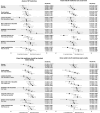The role of constraints and information gaps in driving risky medicine purchasing practices in four African countries
- PMID: 38300508
- PMCID: PMC11005838
- DOI: 10.1093/heapol/czae006
The role of constraints and information gaps in driving risky medicine purchasing practices in four African countries
Abstract
Substandard and falsified (SF) medical products pose a major threat to public health and socioeconomic development, particularly in low- and middle-income countries. In response, public education campaigns have been developed to alert consumers about the risks of SF medicines and provide guidance on 'safer' practices, along with other demand- and supply-side measures. However, little is currently known about the potential effectiveness of such campaigns while structural constraints to accessing quality-assured medicines persist. This paper analyses survey data on medicine purchasing practices, information and constraints from four African countries (Ghana, Nigeria, Sierra Leone and Uganda; n > 1000 per country). Using multivariate regression and structural equation modelling, we present what we believe to be the first attempt to tease apart, statistically, the effects of an information gap vs structural constraints in driving potential public exposure to SF medicines. The analysis confirms that less privileged groups (including, variously, those in rural settlements, with low levels of formal education, not in paid employment, often women and households with a disability or long-term sickness) are disproportionately potentially exposed to SF medicines; these same demographic groups also tend to have lower levels of awareness and experience greater levels of constraint. Despite the constraints, our models suggest that public health education may have an important role to play in modifying some (but not all) risky practices. Appropriately targeted public messaging can thus be a useful part of the toolbox in the fight against SF medicines, but it can only work effectively in combination with wider-reaching reforms to address higher-level vulnerabilities in pharmaceutical supply chains in Africa and expand access to quality-assured public-sector health services.
Keywords: Ghana; Nigeria; Sierra Leone; Uganda; medicine quality.
© The Author(s) 2024. Published by Oxford University Press in association with The London School of Hygiene and Tropical Medicine.
Conflict of interest statement
The authors confirm they have no conflicts of interest to disclose.
Figures









References
-
- Ahiabu MA, Magnussen P, Bygbjerg IC, Terbsol BP. 2018. Treatment practices of households and antibiotic dispensing in medicine outlets in developing countries: the case of Ghana. Research in Social & Administrative Pharmacy 14: 1180–8. - PubMed
-
- Alaszewski A. 2005. Risk communication: identifying the importance of social context. Health, Risk & Society 7: 101–5.
MeSH terms
Substances
Grants and funding
LinkOut - more resources
Full Text Sources
Medical
Miscellaneous

